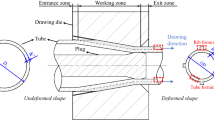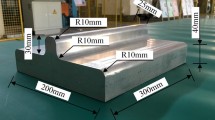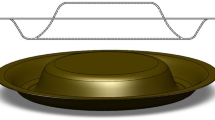Abstract
T-type rib strip was the key connective component between the fuselage and wing of the aircraft and the main processes for preparation of T-type rib strip consisted of forging forming, solution quenching, cold pressing and machining. The variation of residual stress and its effect on the deformation during the final machining process was quite complex. In this study, the numerical models of solution quenching, cold pressing and machining of T-type rib strip was established. The variation of residual stress on the deformation of T-type rib strip was studied. The results show that the maximum quenching stress of the T-type rib was about − 200 MPa at the surface and 150 MPa in the core. A reduction of 60% of the average residual stress can be achieved during the cold pressing process with a reduction rate of 3% and a friction coefficient of 0.3. Compared with direct machining after quenching, the deformation of machining after solution quenching and cold pressing was greatly reduced and the reduction rate reached 65.04%.

















Similar content being viewed by others

References
Branco, R., Costa, J. D., Borrego, L. P., Wu, S. C., Long, X. Y., & Antunes, F. V. (2020). Effect of tensile pre-strain on low-cycle fatigue behaviour of 7050–T6 aluminium alloy. Engineering Failure Analysis, 114, 104592.
Miller, W. S., Zhuang, L., Bottema, J., et al. (2000). Recent development in aluminium alloys for the automotive industry. Materials Science and Engineering A-Structural Materials Properties Microstructural And Processing, 280(1), 37–49.
Ma, H. (2010). Study on distrotion control technology for aero structure based on slotting method. Nanjing University of Aeronautics and Astronautics.
Han, S., Yinfei, Y., Bo, C., & Xiaowei, Z. (2016). Evaluation of residual stress in depth profile of 7055-T7751 pre-stretched aluminum alloy plate. Machine Building & Automation, 45(1), 18–21.
Nervi, S. (2005). A mathematical model for the estimation of the effects of residual stresses in aluminum plates. Washington University.
Prime, M. B., & Hill, M. R. (2002). Residual stress, stress relief, and inhomogeneity in aluminum plate. Scripta Materialia, 46(1), 77–82.
Zhiwei, X. (2017). Research on deformation of aircraft structural parts based on adaptive clamping force. Nanchang Hangkong University.
Withers, P. J. (2007). Residual stress and its role in failure. Reports on Progress in Physics, 70(12), 2211–2264.
Mirkoohi, E., Li, D., Garmestani, H., & Liang, S. Y. (2021). Residual stress modeling considering microstructure evolution in metal additive manufacturing. Journal of Manufacturing Processes, 68, 383–397.
Chobaut, N., Carron, D., Arsène, S., Schloth, P., & Drezet, J.-M. (2015). Quench induced residual stress prediction in heat treatable 7xxx aluminium alloy thick plates using Gleeble interrupted quench tests. Journal of Materials Processing Technology, 222, 373–380.
Morin, L., Braham, C., Tajdary, P., Seddik, R., & Gonzalez, G. (2021). Reconstruction of heterogeneous surface residual-stresses in metallic materials from X-ray diffraction measurements. Mechanics of Materials, 158, 103882.
Acevedo, R., Sedlak, P., Kolman, R., & Fredel, M. (2020). Residual stress analysis of additive manufacturing of metallic parts using ultrasonic waves: State of the art review. Journal of Materials Research and Technology, 9(4), 9457–9477.
Nycz, A., Lee, Y., Noakes, M., Ankit, D., Masuo, C., Simunovic, S., Bunn, J., Love, L., Oancea, V., Payzant, A., & Fancher, C. M. (2021). Effective residual stress prediction validated with neutron diffraction method for metal large-scale additive manufacturing. Materials & Design, 205, 109751.
Babaeeian, M., & Mohammadimehr, M. (2021). Experimental and computational analyses on residual stress of composite plate using DIC and Hole-drilling methods based on Mohr’s circle and considering the time effect. Optics and Lasers in Engineering, 137, 106355.
Murugan, N., & Narayanan, R. (2009). Finite element simulation of residual stresses and their measurement by contour method. Materials & Design, 30(6), 2067–2071.
Anais, J., Jeferson, O., Ali, M., Foroogh, H., Joe, K., & Filippo, B. (2018). Residual stress measurements in offshore wind monopile weldments using neutron diffraction technique and contour method. Theoretical and Applied Fracture Mechanics, 96, 418–427.
Zhao, L., Santos Macías, J. G., Dolimont, A., Simar, A., & Rivière-Lorphèvre, E. (2020). Comparison of residual stresses obtained by the crack compliance method for parts produced by different metal additive manufacturing techniques and after friction stir processing. Additive Manufacturing, 36, 101499.
Song, H. (2015). Study on machining distortion of 7055 wing panel. Nanjing University of Aeronautics and Astronautics.
Keith, A. Y. (2005) Machining-induced residual stress and distortion of thin parts. Ph.D. dissertation. Washington University, USA.
Zhang, Z. (2015). Research on residual stress and machining distortion of aeronautic weak rigidity in aluminum structure. Nanjing University of Aeronautics and Astronautics.
Rai, J. K., & Xirouchakis, P. (2008). Finite element method based machining simulation environment for analyzing part errors induced during milling of thin-walled components. International Journal of Machine Tools & Manufacture., 48(6), 629–643.
Bi, Y. B., Dong, H. Y., Cheng, Q. L., et al. (2009). Distortion prediction of aerospace monolithic components due to milling process. Key Engineering Materials., 392–394, 841–847.
Zhang, F., Yang, C., Yuan, W., & Wang, X. (2018). Study on quenching residual stress and reducing process of 7050 aluminum alloy. Hot Working Technology, 47(24), 177–180.
Funding
This study was funded by the National Natural Science Foundation of China (Grant Number: 51327902, U1637601), the State Key Laboratory of High Performance and Complex Manufacturing (Grant Number: Kfkt2016-04).
Author information
Authors and Affiliations
Contributions
Conceptualization: YL, HG, YH, TZ, YS; Validation: YL, HG, YH, TZ, YS, XL; Formal analysis: YL, HG, YH; Investigation: YL, HG, YH, TZ, YS, XL; Writing-Review and Editing: YL, HG; Supervision: YL.
Corresponding authors
Ethics declarations
Conflict of interest
The authors declare no conflict of interest.
Additional information
Publisher's Note
Springer Nature remains neutral with regard to jurisdictional claims in published maps and institutional affiliations.
Rights and permissions
About this article
Cite this article
Liu, Y., Gong, H., He, Y. et al. Research on Machining Deformation of 7050 Aluminum Alloy Aircraft Rib Forging. Int. J. Precis. Eng. Manuf. 23, 533–543 (2022). https://doi.org/10.1007/s12541-022-00640-3
Received:
Revised:
Accepted:
Published:
Issue Date:
DOI: https://doi.org/10.1007/s12541-022-00640-3



